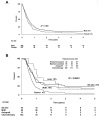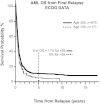The myth of the second remission of acute leukemia in the adult
- PMID: 23243288
- PMCID: PMC3575753
- DOI: 10.1182/blood-2012-08-234492
The myth of the second remission of acute leukemia in the adult
Abstract
Although the majority of adult patients with both acute lymphoblastic leukemia and acute myelogenous leukemia achieve remission with upfront chemotherapy, many patients still suffer relapse. Often, the strategy is proposed of treating patients with relapsed leukemia into a second remission (CR2) and then proceeding to allogeneic transplantation as the definitive curative approach. However, the long-term outcomes of such a strategy are poor: the 5-year overall survival from first relapse for patients with acute leukemia is only approximately 10%. This Perspective highlights the fact that most patients do not achieve CR2 and therefore never really have an opportunity for a potential curative therapy. Although patients who undergo transplantation after relapse may be cured, those who do not achieve CR2 are rarely candidates for transplantation; therefore, the overall outcome for patients who relapse is dismal. There is therefore an urgent need not only for more effective upfront therapy to prevent relapse, but also for the development of therapies that can serve as effective bridging treatments between relapse and transplantation. We suggest that more optimal use of minimal residual disease detection during first remission may also improve the chances for successful transplantation therapy via earlier reinduction therapy, allowing transplantation before overt relapse.
Figures





Comment in
-
Correcting 2 more myths regarding transplants for AML in second remission.Blood. 2014 Jan 30;123(5):794. doi: 10.1182/blood-2013-12-541508. Blood. 2014. PMID: 24482501 No abstract available.
References
-
- Dohner H, Estey EH, Amadori S, et al. Diagnosis and management of acute myeloid leukemia in adults: recommendations from an international expert panel, on behalf of the European LeukemiaNet. Blood. 2010;115(3):453–474. - PubMed
-
- Cornelissen JJ, Gratwohl A, Schlenk RF, et al. The European LeukemiaNet AML Working Party consensus statement on allogeneic HSCT for patients with AML in remission: an integrated-risk adapted approach. Nat Rev Clin Oncol. 2012;9(10):579–590. - PubMed
-
- Estey EH. Acute myeloid leukemia: 2012 update on diagnosis, risk stratification, and management. Am J Hematol. 2012;87(1):89–99. - PubMed
-
- Schoch C, Kern W, Schnittger S, Buchner T, Hiddemann W, Haferlach T. The influence of age on prognosis of de novo acute myeloid leukemia differs according to cytogenetic subgroups. Haematologica. 2004;89(9):1082–1090. - PubMed
Publication types
MeSH terms
Grants and funding
LinkOut - more resources
Full Text Sources
Other Literature Sources
Medical

